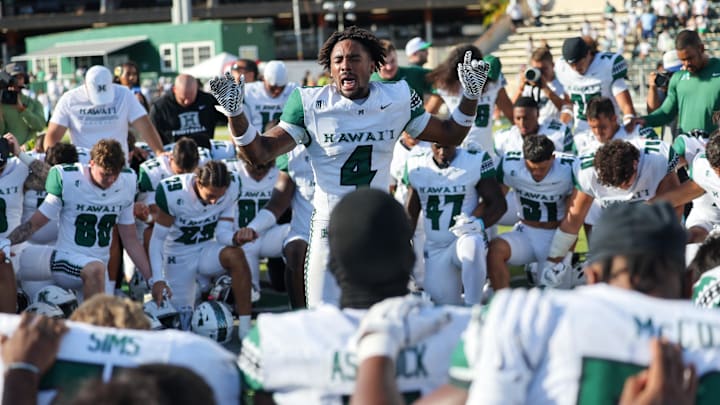Playing an updated version of the run-and-shoot Hawaii will challenge Arizona defensively by frequently playing four wide receivers to spread the defense out. Eight of the players listed as first-team defense by Arizona are returnees from 2025.
Hawaii is led by quarterback Micah Alejado offensively. Alejado is probable after sustaining an ankle injury versus Stanford. Alejado had 27 completions in 39 attempts for 210 yards, two touchdowns and no interceptions and 10 carries for 36 yards against Stanford.
Nine different Hawaii receivers caught passes versus Stanford. Hawaii wide receivers Pofele Ashlock and Nick Cenacle were named preseason All-Mountain West. Ashlock led Hawaii with nine receptions for 69 yards and a TD versus Stanford. Jackson Harris had six receptions for 59 yards and a TD.
Cenacle led Hawaii with 63 receptions and 721 receiving yards in 2024 and tied Ashlock for the team lead with six TD catches. Stanford held Cenacle to three receptions for 12 yards. Hawaii was methodical offensively versus Stanford with six drives of at least six plays.
Hawaii had 40 pass attempts and 24 runs for 96 yards versus Stanford. Cam Barfield led Hawaii with six carries for 45 yards against Stanford. Hawaii had four runs of over 10 yards against Stanford. Alejado had the longest run for 30 yards.
Stanford was successful in getting Hawaii into third down. Hawaii converted three of 10 on third down. The average third-down distance for Hawaii was 7.7 yards. Alejado completed four passes in eight attempts for 36 yards on third down. On first down Alejado completed seven passes in 14 attempts for 37 yards.
Alejado finished 15 of 16 passes for 136 yards, including two touchdowns, nine first downs, three completions of 15 yards or more, and one for 25 yards on second down. Those three completions were the only ones Hawaii had for 15 or more yards versus Stanford.
Lock in those plans 😼
— Arizona Athletics (@AZATHLETICS) August 26, 2025
Fan Info 📲 https://t.co/gwFcdFydl7 pic.twitter.com/jo02yjHgPS
In the fourth quarter Alejado completed 10 passes in 15 attempts for 94 yards with five for first downs, two completions of 15 or more yards and the only one for 25 as Hawaii rallied from a 20-17 deficit. Harris had three receptions for 22 yards on the game-winning drive.
In addition to limiting Hawaii on third down, Stanford sacked Hawaii four times for a loss of 21 yards. Getting pressure on Alejado is critical for Arizona. The best defense for Stanford was time of possession. Stanford had possession for 36:06 on offense and an advantage of 73 plays to 64.
Four Stanford drives were at least 10 plays but only resulted in 13 points with a missed field goal and an interception. Run-and-shoot teams typically struggled in short yardage and in pass protection with four WRs and one running back usually lined up. Those should be areas Arizona can exploit Hawaii.
